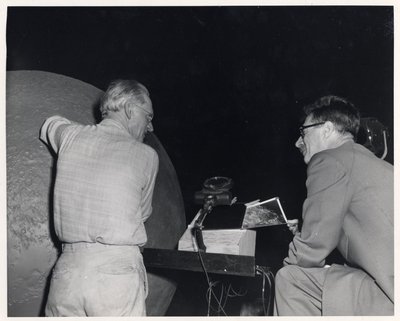While the Beroju Theatre shows continued to be produced throughout the 1930s, Roger also sought to immerse himself in scientific theories while undertaking several additional projects. His first actual attempt at scientific work was the construction of a 6-inch reflector style telescope. It took him around five years to complete the device, but the work gave him added incentive to study principles of mathematics and astronomy during his free time. He was also tutored by various associates from Caltech in atomic theory, which encouraged his study of physics and optics. Though sparse architectural work was the main catalyst that led Roger down his new path of scientific pursuits, he was happy to comply with the conditions of his gradually altered circumstances:
“The profession of architecture seemed to satisfy my aesthetic and technical nature quite nicely until about 1932. It was at that time that I began to feel that my outlook was too limited, particularly in the direction of science.... I felt acutely my own lack of scientific knowledge.”
Roger’s studies and interest in physics, atomic theory and geometrical optics eventually resulted in his construction of a quartz spectrograph, an endeavor that would later provide him with temporary employment during a time of need. His close association with astronomers, construction of his telescope and his history with sculpture likewise provided him with the opportunity to design and build a 35-foot exact scale model of the moon for the Griffith Observatory and Planetarium in 1934. Roger took great pains to match the contours of the moon using fine astronomical photographs along with direct observation using the Mt. Wilson telescope. With the help of Caspar Greunfeld and the use of about two hundred pounds of plasteline clay, Roger ended the experience as a bona fide selenographer.
The moon model job provided Roger with much needed employment, but also prompted his first direct contact with the Mt. Wilson Observatory. The relationship supplied him with his first use of the observatory’s 100-inch telescope, an experience that he happily extended for about three hours and revisited as often as he could. Roger’s work on the moon model was also highly publicized in the press, including mention in the Pasadena Post, Los Angeles Herald, New York Times, Worcester Daily Telegram, Boston Herald, Albany Times, Literary Digest, Christian Science Monitor, Keene Evening Sentinel and various reprints in international news media. As could be expected, he was given to fond recounting of this unique moment in his life in future correspondence with friends, associates and professional reviews.

Telescope built by Roger Hayward, ca. 1935-1936. More images here

Roger Hayward and Caspar Gruenfeld working on the Griffith Observatory moon model, ca. 1934. More images here
